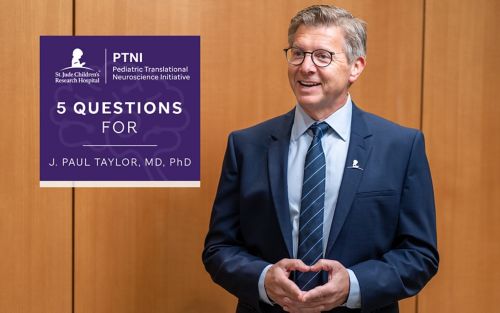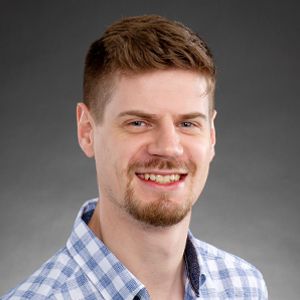St. Jude Family of Websites
Explore our cutting edge research, world-class patient care, career opportunities and more.
St. Jude Children's Research Hospital Home

- Fundraising
St. Jude Family of Websites
Explore our cutting edge research, world-class patient care, career opportunities and more.
St. Jude Children's Research Hospital Home

- Fundraising
5 Questions for J. Paul Taylor, MD, PhD

J. Paul Taylor, MD, PhD, identified an opportunity at St. Jude to advance treatment strategies for pediatric neurological disease. This grew into the Pediatric Translational Neuroscience Initiative which, in its fourth year, is beginning to hit its stride.
This question-and-answer series explores the origins, goals and accomplishments of St. Jude investigators. At St. Jude, J. Paul Taylor, MD, PhD, serves as an Executive Vice President, Scientific Director, Chair of the Department of Cell and Molecular Biology and Director of the St. Jude Pediatric Translational Neuroscience Initiative (PTNI). Through his clinical background in neurogenetics and research background in molecular biology, Taylor sought to leverage the advances made in neurological disease research to address the unmet need for available treatments for catastrophic neurological disorders in children.
Taylor’s arrival at St. Jude in 2008 was the first building block of what would later be the formation of PTNI in 2020. Taylor is regarded as one of the most highly cited scientists in the world and has been honored with the prestigious Potamkin Prize sponsored by the American Academy of Neurology.
In addition to his many leadership roles, Taylor’s laboratory continues to study the molecular origins of neurological diseases ranging from neurodevelopmental disorders to neurodegeneration. As PTNI expands, Taylor and his colleagues in the program are bridging research and clinical endeavors to address the needs of a unique patient population.
1. St. Jude is known worldwide for providing pediatric cancer care – what about the St. Jude environment encouraged you to pursue a program to address rare neurological diseases in children?
All the conditions we treat at St. Jude fit into the rare disease category – and 80% of these have a genetic component. While St. Jude was first presented to me as a pediatric cancer hospital, to me it is where we treat rare catastrophic diseases in kids.
When I joined the hospital, I gave up clinical work to focus on my lab. At a certain point, I got tapped to be on a committee called the Clinical Trial Scientific Review Committee. It exposed me to everything that was going on in clinical research at St. Jude. One thing I noticed was that many challenges that one faces in doing clinical trials are taken care of for you here. I’ve never seen infrastructure like we have in place here to support clinical trial research in children, it’s truly incredible.
So, the seed of the idea for PTNI came about by seeing how St. Jude addressed other complex catastrophic diseases. I wondered, “Why aren’t we doing this for neurological diseases?"
2. Setting up a program like PTNI does not happen in a vacuum. What kind of support and encouragement did you receive from your peers as the idea behind PTNI formed?
Being able to drop by the office of our St. Jude President and CEO, Dr. James Downing, to talk was tremendously helpful in shaping PTNI. In 2013 I visited a company developing antisense oligonucleotides (ASO) and when I returned, I told Dr. Downing, "I just saw the most unbelievable stuff."
They were looking to address spinal muscular atrophy, a relentlessly progressive fatal disease that is completely untreatable. It involves a loss-of-function mutation in a gene called SMN. They developed an ASO which triggers the expression of the backup SMN gene enough to cure the disease.
We discussed it, and I said if we got into this, we could have a huge impact. Downing’s response was, "What would it take to do this?”
I also built a network of people whom I called to ask, "What would you do? Where are the gaps?” Within a year, I had talked to probably 90 people, never with a sense of competition. What I heard was, "We need this." It was very encouraging.
3. A program encompassing everything from fundamental research to clinical application has a lot of moving parts. Based on the needs in the field, how did you envision what structure PTNI would take?
Three things that were clear to me very early on. One was that there was going to have to be a clinical program. The biggest challenge in the field was a bottleneck in running clinical trials. There is plenty of data on diseases that we can potentially treat because we know and understand the genes. The Center of Experimental Neurotherapeutics (CENT) was set up to advance these treatments through clinical trials.
It was also clear early on that a clinical trial program without fundamental research support was going to be really limited. We needed to have people who would start with the genetic mutation to figure out why it is causing a defect. That infrastructure became the Center for Pediatric Neurological Disease Research (CPNDR).
We also knew we were going to need to engage industry and consider what is going to appeal to them. So, we must consider these industry relations, but then there is maintaining patient interaction, and coordination with internal and external academics, too. All these needs formed the basis of the Office of Strategy and Alliances (OSA).
4. When it was time to fill the leadership roles for these programs, how did you identify the correct people for the jobs?
What I am proudest of is having picked the right leaders for the programs.
The best way to recruit to St. Jude is to get people to physically visit the hospital. So, we held our first PTNI workshop in 2018, and I invited many people in the field of neurological diseases to give talks. People were impressed with the seriousness, sense of purpose and resources of St. Jude. I also got to see how participants engaged with people at St. Jude, and I ended up recruiting four individuals who stood out to me as each having distinct skills and capabilities to accelerate the program to bring it to maturity quickly.
One of those is the head of the CENT program, Dr. Richard Finkel, who was one of the speakers at that symposium. Kristin Stephenson, who runs our Office of Strategy and Alliances, was the representative from the Muscular Dystrophy Association at that meeting. Dr. Heather Mefford, who became the first outside faculty recruit into CPNDR, spoke about the genetics of epilepsy, and how that could be converted into precision medicine.
I had known Dr. Peter McKinnon for 10 years as a leader in the field of neurological consequences of mutations in the DNA damage response system. The idea to recruit him to be the head of CPNDR came from seeing him engaged for two full days in the workshop, genuinely curious, participating and asking questions.
5. As PTNI grows how is St. Jude uniquely positioned to make a difference in pediatric neurologic disease?
If you had asked me at the outset to design PTNI from scratch and submit it as a grant, I would have gotten at least 30% of it, if not half of it, wrong. This program and I benefitted from an internal St. Jude model that allows you to develop big ideas.
We know that there are a lot of industrial and academic places that are developing gene therapies and small molecules and a variety of different candidate therapies. We are well positioned to take them in and facilitate clinical trials. What PTNI provides in this context is an opportunity to advance treatment strategies that are not going to move forward without this intervention.
We have multiple trials running at the same time through CENT. We have a functioning fundamental research program on which we can piggyback any neurological disease that comes along. We can screen therapeutics in CPNDR, identify the lead candidates and test them in our labs. And then we have the OSA, which is coordinating relationships with internal and external entities. Essentially, we are positioning ourselves to intervene in any disease where there is a clear genetic target. To me, that is a great thing. This is how we improve therapy for kids.







